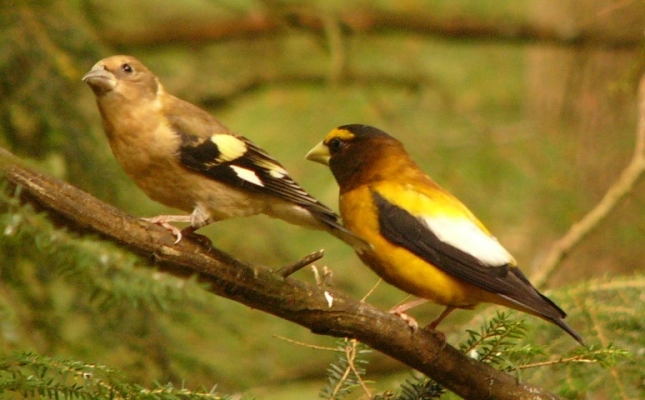BIRD OF THE MONTH: EVENING GROSBEAK
The Evening Grosbeak is a heavyset finch of northern coniferous forests. It is found in the Rocky Mountains and northern parts of North America. It breeds as far south as Mexico
The male has a yellow body, dusky head, white wing patches and a fierce yellow eye stripe. The female has soft gray plumage with golden highlights.
With its massive beak, the Evening Grosbeak loves to eat all kinds of seeds, invertebrates such as larvae, caterpillars and aphids, small fruits like cherries, crabapples, snowberries and ash fruit, and the buds of trees like maple, elm, willow, oak, aspen and cherry. It will also drink maple sap by breaking off small maple twigs.
Typically it likes to feed at the tops of trees and shrubs but sometimes will come to the ground for fallen fruits and seeds or capture insects in flight.
You will find an Evening Grosbeak's nest high in a tree or large shrub. It is unknown whether the male or female chooses the nest site.
A flimsy, saucer-shaped nest is made of small twigs and roots and lined with grasses, lichens and pine needles. It is about 5 inches high, with the inner cup measuring about 3 inches across and 1 inch deep. The female does most of the nest building.
Eggs are light blue to blue-green with brown or purplish blotches. The female will lay 2 - 5 eggs and will incubate them for 12 - 14 days. The chicks are helpless when hatched, with eyes closed and skin partly covered with white down. The nestlings will fledge in 13 - 14 days.
The Evening Grosbeak is a social bird that forages in flocks in winter. It is an irregular (irruptive) winter migrant sometimes showing up at feeders far south of their normal winter range. During the breeding season it will forage in small groups or in pairs.
The Evening Grosbeak is a songbird without a song. It does not seem to use any complex sounds to attract a mate or defend its territory. It does have a small repertoire of simple calls, including sweet, piercing notes and burry chips.
In the mid-1800's, the Evening Grosbeak was uncommon to rare east of the Rockies. It began moving eastward with each winter migration and reached Rhode Island in the winter of 1910-1911. By the 1920's, it was a regular visitor in New England. This eastward expansion may be due to the growing number of ornamental box elders which provide a steady food supply for this bird.
The Evening Grosbeak is numerous and widespread, but populations dropped steeply between 1966 and 2015. This may be due to logging and other development in the boreal forests of northern North America; to diseases such as salmonella, West Nile virus and House Finch eye disease; or to reduced numbers of spruce budworm and other forest insects partly due to aerial spraying by the U.S. and Canada. The Evening Grosbeak rates a 13 out of 20 on the Continental Concern Score and is on the 2016 State of North America's Birds' Watch List. This list includes bird species that are most at risk of extinction without significant conservation actions to reverse declines and reduce threats.
The oldest recorded Evening Grosbeak was a male and it was at least 16 years, 3 months old when he was found in New Brunswick in 1974. He had been banded in Connecticut in 1959.


